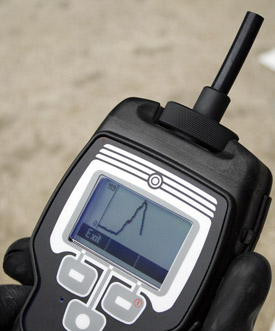 Most Chemical Warfare Agent Detectors Are Not Good “Sniffers” for Decon
The ChemPros are the only Chemical Warfare Agent (CWA) detection products that are also excellent “sniffers.” Traditionally CWA detectors only responded when they had reached the alarm threshold level. Levels below the alarm threshold level typically went unseen. Detection took time, as the algorithms were often written to provide good chemical ification and low false alarms at the cost of detection speed. This resulted in detection times of 30-120 seconds even when CWA detectors were used to sniff on “neat” or pure agent. Practically this meant that, when using many CWA ifiers, users had to scan very slowly with virtually unperceivable movement, like scanning for alpha radiation, in order to find and ify the contaminants.
Most Chemical Warfare Agent Detectors Are Not Good “Sniffers” for Decon
The ChemPros are the only Chemical Warfare Agent (CWA) detection products that are also excellent “sniffers.” Traditionally CWA detectors only responded when they had reached the alarm threshold level. Levels below the alarm threshold level typically went unseen. Detection took time, as the algorithms were often written to provide good chemical ification and low false alarms at the cost of detection speed. This resulted in detection times of 30-120 seconds even when CWA detectors were used to sniff on “neat” or pure agent. Practically this meant that, when using many CWA ifiers, users had to scan very slowly with virtually unperceivable movement, like scanning for alpha radiation, in order to find and ify the contaminants.
PIDs as “Sniffers” with CWA Detectors Because of lack of sensitivity and speed, CWA detectors could not easily be used as “sniffers” to determine where the agent was originating. To address this shortcoming, CWA detectors were often supported with sensitive and fast responding, broadband detectors like Photoionization Detectors (PIDs) to locate contamination and then CWA detectors were used to ify the contamination (for more on this please reference Environics Application Note 102 “Decision-making in Chemical Warfare Agent Response”).
With “Trend” Display, the ChemPro Is the Only CWA Detector that Can “See” Below Alarm Levels The ChemPro is unique among CWA detectors because it is a sniffer and a ifier in one product. The “Trend” mode in the ChemPro allows it to be used as a sniffer to locate areas of higher concentration. By watching the rolling graph of the “Trend” display, one can virtually see changes in concentration instantly. With the Trend display in the ChemPro family of detectors, the ChemPro can quickly and easily be used as a sniffer. The Trend display shows a rolling line graph where the left or “Y” axis represents relative concentration units and the bottom or “X” axis represents time. In a clean environment, there is a relatively straight line across the bottom of this graph. However, when presented with a contaminant, the Trend graph will instantly generate a peak and then quickly recover when the contaminant is removed. By observing this graph of the concentration trend, the user can quickly differentiate a contaminated area from a clean area.
The Trend Display Still Provides Alarms
If the ChemPro goes into alarm while in the Trend display, the nature of the ification alarm will be  displayed in text at the top of the Trend screen so that users will never miss an alarm annunciation just because they are using the Trend display.
displayed in text at the top of the Trend screen so that users will never miss an alarm annunciation just because they are using the Trend display.
The ChemPro Can “See” Much More than a PID While the ChemPro is a multi-sensor or “orthogonal” detector, its core technology is Ion Mobility Spectroscopy (IMS) where chemicals are ionized, or broken down into positive and negative ions, and then the ions are sorted so that the unknown chemicals can be ified into functional groups. While PIDs also break down chemicals into positive and negative ions, they only count the total ion flow and they do not sort ions to provide ifications of chemicals like the ChemPro. PIDs are usually limited to sniffing chemicals with ionization potentials of 10.6eV or less so they cannot see chemicals with ionization potentials higher than 10.6eV like chlorine (11.47eV). The Americium (AM241) ionization source of the ChemPro produces 60,000eV so it can “see” many more chemicals with high ionization potentials (like chlorine and even Sarin) that go unseen or are poorly seen by most PIDs. AM241 is commonly used in smoke detectors and the ChemPro is covered by the same Nuclear Regulatory Commission exemption as smoke detectors. The ChemPro is not just limited to sniffing CWA – it can also be used for Toxic Industrial Chemical (TIC) contamination.
The ChemPro Stores Well Some CWA/TIC detectors need to be “exercised” or run once per day/week/month or else their sensors will “go to sleep” and they will not work when an emergency comes. In other detectors, sensors will go bad simply from being on the shelf. The ChemPro can be stored for years and if it was working when it was stored, the ChemPro will work when it is really needed. Even if the last user forgot to put it back on charge, it takes just seconds to pop an alkaline pack into the ChemPro and it is immediately ready for use. This is very important for decon programs that do not routinely use their CWA detector.
The ChemPro Is Inexpensive to Maintain Decon teams are often unaware of the logistics required to keep many CWA detectors running. CWA detectors have proven to be expensive and time consuming for most users to maintain. The ChemPro has the lowest logistics footprint of any detector in its . Environics’ costs are so low that they offer a 5-year Guaranteed Cost of Ownership program that covers any repairs, not due to abuse, and upgrades for the first 5 years of ownership of the ChemPro. Environics is the ONLY company to offer such a program for a CWA detector.
Small Size, Non-Threatening Shape The small size and non-threatening form of the ChemPro will be less threatening to civilians than many ical “military-looking” CWA detectors. The small size of the ChemPro allows it to be used for hours without fatigue.
Do Not Forget Nerve Agent Symptoms When using the ChemPro on decon of personnel potentially exposed to nerve agents, it is important to also note the symptoms of nerve agent exposure. Sometimes victims will start to display symptoms at contamination levels that stress the capabilities of all CWA detectors. There are two major mnemonics used to remember human (and animal) nerve agent symptoms: DUMBBELLS and SLUDGEM. Each captures many of the same symptoms somewhat differently.
DUMBBELLS
D - Diarrhea (Diaphoresis-excessive sweating) U - Urination (peeing) M - Miosis (constriction of the pupil of the eye) B - Bronchospasm (difficulty breathing) B - Bradycardia (slow heart beat) E - Excite skeletal muscle and central nervous system emesis (vomiting) L - Lacrimation (tearing) L - Lethargy (fatigue) S - Salivation (excessive drooling)
SLUDGEM
S - salivation (excessive drooling) L - lacrimation (tearing) U - urination D - defecation/diarrhea G - gastro-intestinal upset (cramps) E - emesis (vomiting) M - muscle (twitching, spasm, “bag of worms”)
Severity of symptoms is dose dependant
In Brad Rowland’s, Dugway Proving Ggrounds, words, “The eyes may be the window to the soul, but they also can serve as an agent alarm” (i.e., miosis).
____________________________ Christopher Wrenn is the Sr. Director of Sales and Marketing for Environics USA, a provider of sophisticated gas & vapor detection solutions for the military, 1st responder and safety markets. Previously Mr. Wrenn was a key member of the RAE Systems team. Chris has been a featured speaker at more than 20 international conferences and has written numerous articles, papers and book chapters on gas detection in HazMat and industrial safety applications.
